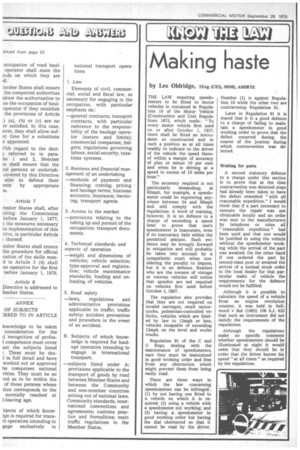Making haste
Page 56

If you've noticed an error in this article please click here to report it so we can fix it.
by Les Oldridge, TEng (CE!), MIMI, AMIRTE THE LAW requiring speedometers to be fitted to motor vehicles is contained in Regulation 18 of the Motor Vehicle (Construction and Use) Regulations 1973, which reads : "To every motor vehicle first used on or after October 1, 1937, there shall be fitted an instrument so constructed and in such a position as at all times readily to indicate to the driver of the vehicle the speed thereof within a margin of accuracy of plus or minus 10 per cent and when he is driving at a speed in excess of 10 miles per hour."
The accuracy required is not particularly demanding; at 60mph, for example, a speedometer could be registering anywhere between 54 and 66mph and still comply with the regulations. A word of warning, however. It is no defence to a charge of exceeding a speed limit to prove that one's speedometer is inaccurate, even if its inaccuracy falls within the permitted amount. Such evidence may be brought forward in mitigation and will probably be taken into account by a sympathetic court when considering the penalty to impose, but it is no defence. Readers who are the owners of vintage or veteran vehicles will notice that speedos are not required on vehicles first used before October 1, 1937.
The regulation also provides that they are not required on invalid carriages, small motorcycles, pedestrian-controlled vehicles, vehicles which are limited by law to 12mph or less, vehicles incapable of exceeding 12mph on the level and works trucks.
Regulation 91 of the C and U Regs, dealing with the maintenance of speedometers, says they must be maintained in good working order and free from any obstruction which might prevent them from being easily read.
There are three ways in which the law concerning speedometers can be infringed : (1) by not having one fitted to a vehicle on which it is required; (2) using a vehicle with a speedometer not working; and (3) having a speedometer in good working order but having the dial obstructed so that it cannot be read by the driver. Number (1) is against Regulation 18 while the other two are contravening Regulation 91.
Later in Regulation 91 it is stated that it is a good defence to a charge of failing to maintain a speedometer in good working order to prove that the defect occurred during the course of the journey during which contravention was detected.
Waiting for parts
A second statutory defence to a charge under this section is to prove that at the time contravention was detected steps had already been taken to have the defect remedied "with all reasonable expedition." I would think that if a part necessary to execute the repair was not obtainable locally and an order was sent to the manufacturers by telephone or telex all "reasonable expedition" had been used and that one would be justified in using the vehicle without the speedometer working while the arrival of the part was awaited. On the other hand if one ordered the part by second-class post or awaited the arrival of a normal stock order to the local dealer for that particular make of vehicle the requirements for the defence would not be fulfilled.
Although it is possible to calculate the speed of a vehicle from an engine revolution counter, it was held in Sell-, wood v But (1962) 106 S.J. 835 that such an instrument did not satisfy the requirements of the regulations.
Although the regulations make no specific comment whether speedometers should be illuminated at night it would seem that they should be in order that the driver knows his speed "at all times" as required by the regulations.




































































































